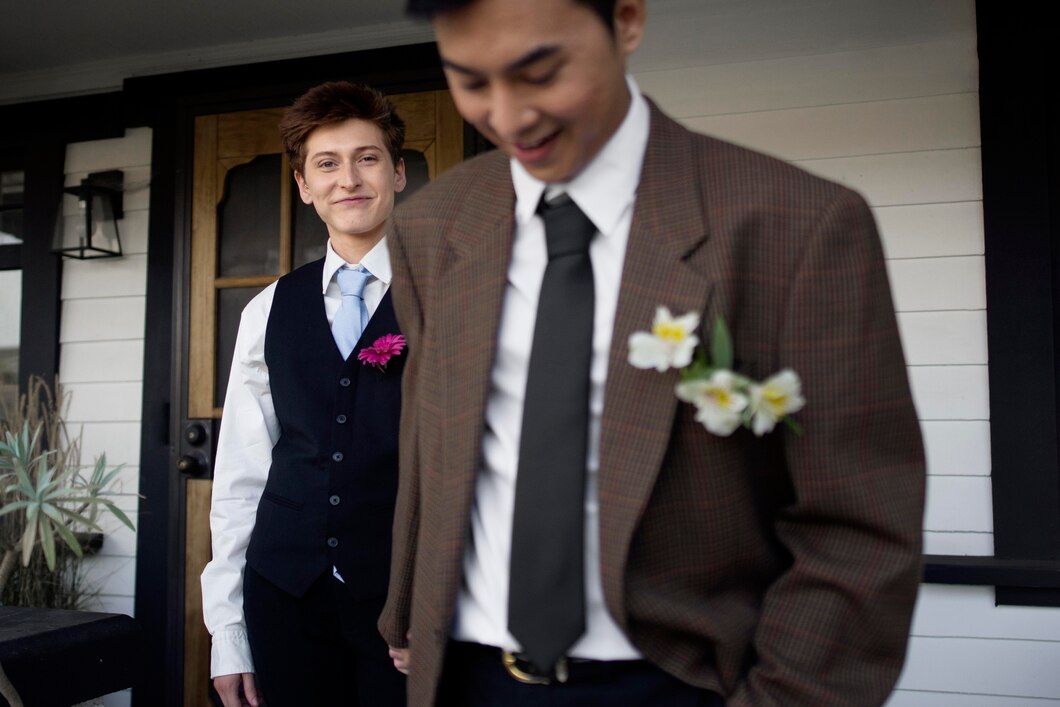Can You Wear a Tuxedo to a Wedding as a Guest?

Mens wedding tuxedos are like the crown jewel of men’s formal wear. It’s all about sophistication, featuring details like satin lapels, buttons, and side stripes on the trousers. The classic black tux gives off that unmistakable James Bond vibe—elegant, sleek, and undeniably dapper.
Can you wear a tux just as a guest? Absolutely, if the dress code aligns with black-tie, or you’re looking at a more formal evening event. It’s a stellar way to match the occasion’s extravagance and ensures you’re dressed to impress while blending seamlessly into the sophisticated ambiance.
Bridegroom’s and Guest’s Tuxedos
When it comes to the tuxedo for the bridegroom and guests, the difference can be subtle, yet significance lies in the details and the overall vibe. Typically, the bridegroom’s attire will have a few unique touches to distinguish him, such as a special boutonniere, a personalized cufflink set, or a slightly different style or color that nods to the wedding’s theme or palette.
For guests, the aim is to look sharp and classy while keeping the spotlight on the newlyweds. It’s akin to a supportive role in a play, where you enhance the scene without stealing it. So sticking to classic styles and colors is a safe bet. And remember, it’s all about complementing rather than competing.
One unwritten rule akin to good manners is avoiding anything overly flashy or extravagant—a brightly colored tux, for example, might detract attention rather than add harmony. The beauty of fashion at weddings lies in its subtlety and its ability to express elegance without detracting from the couple’s big day.
Additionally, wedding dress codes exist to help maintain a level of cohesion and reflection of the event’s tone, much like good etiquette makes social interactions smoother and more enjoyable for everyone involved.
Understanding Wedding Dress Codes
When is it appropriate to don a tuxedo at a wedding? It largely comes down to the dress code specified on the invitation, often referred to as “black tie.” If it’s a black-tie wedding, a tuxedo is definitely the go-to choice. This means the hosts envision an elevated level of formality, where tuxedos and evening gowns reign supreme.
But who typically decides these dress codes? The bride-to-be, often accompanied by her partner and sometimes with the help of a wedding planner. They craft the vision for their big day, from venue to attire, setting the tone for their guests to follow.
If the dress code simply states “formal” or “black-tie optional,” you still have the green light for a tux, but a dark suit can work too if you’re feeling more understated. The key is to match the tone while adding your personal flair.
Formal vs. Semi-Formal Attire
Formal Attire—This generally aligns with black-tie rules. Think tuxedos or dark suits with a white shirt and a tie or bow tie. You’re aiming for polished elegance. It’s appropriate for evening weddings and upscale venues.
Semi-Formal Attire—A touch more relaxed but still spiffy. Think suits in darker hues for evening events or lighter shades for daytime. You can mix in a bit of pattern or color with your tie or pocket square for flair. No need for a tux, but showing up in one wouldn’t be out of line if you jazz it up.
Black-Tie vs. White-Tie
Black-Tie Weddings—This is the tuxedo’s natural habitat. You’ll want the full kit – tuxedo jacket, trousers with satin stripe, formal white shirt, black bow tie, and traditional patent leather shoes. A polished look that speaks volumes of understated elegance.
White-Tie Weddings—The pinnacle of formality, even more than black tie. Tailcoats, white waistcoats, and white bow ties are the staples. Think state banquets or royal affairs – this isn’t for your everyday wedding. They’re rare, but if the invitation demands it, you’ll go all out.
The historical debut of the tuxedo is often associated with Griswold Lorillard, who reportedly rocked the first dinner jacket (ancestor to the modern tux) at a ball in 1886 at the Tuxedo Park Club in New York. Since then, the tuxedo elegantly infiltrated the world of formal events.
Wedding codes can be fluid, especially with creative or themed celebrations. It’s wise to keep a sharp eye on the invitation details and clarify any ambiguities with the hosts. Better to be ready with a couple of options, especially if you sense a whimsical theme in the mix.
Factors to Consider Before Wearing a Tuxedo
Time of Day
For evening weddings, a classic black tuxedo is a timeless choice.
For daytime weddings, you might consider a tux in lighter shades, like gray or navy. Though traditionalists stick to black for tuxedos, semi-formal daytime events offer a bit more leeway.
Location
A beach or garden wedding calls for lighter fabrics and possibly a more relaxed cut.
A ballroom or formal setting gravitates towards classic midnight blue or black tuxedos.
Selecting Your Black-Tie Tuxedo
Fit is King: Make sure the tuxedo is well-tailored. The shoulders should align just right, and the trousers should have a slight break over the shoes.
Fabric Matters: Wool is your go-to for comfort and breathability, with blends offering a slightly relaxed drape. Velvet or silk options can add a luxe texture if you’re feeling adventurous.
Details, Details: Notch or peaked lapels, shiny versus matte lapels, single or double-breasted – these are your customizable features. Choose based on personal style and physique.
Transforming Your Tuxedo
For White-Tie
Swap the black bow tie for a white one.
Add a white waistcoat beneath.
If you have a tailcoat, wear it over your standard tuxedo trousers.
For Semi-Formal
Pair your tuxedo jacket with slacks in a complementary color.
Opt for a regular long tie instead of a bow tie.
Consider a more colorful or patterned pocket square for a relaxed flair.
Maximize Versatility
The key to one tux for all occasions is flexibility in accessories—a collection of bow ties, waistcoats, and pocket squares.
Shoes can transform an outfit. Classic patent leather for formal, or a polished Oxford for semi-formal.
Investing in a quality black tuxedo lays a staple foundation in your wardrobe. With a few choice adjustments, you can dip seamlessly between dress codes. Essential, yet versatile.
Here’s the deal: weddings are all about celebrating love and unity, so while honoring the dress code is important, it’s also your chance to express your own style. So find that sweet spot between tradition and your personal fashion statement, and you’ll be stepping confid
ently and classily into any wedding invitation you accept.




